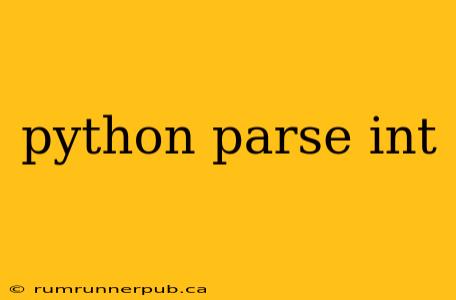Parsing integers is a fundamental task in any programming language, and Python offers a straightforward yet powerful way to do so with its built-in int() function. This article will explore the nuances of Python's int() function, drawing upon insights from Stack Overflow to provide a comprehensive understanding. We'll delve beyond the basics, examining common pitfalls and advanced usage scenarios.
What is int() in Python?
The int() function in Python converts a given value into an integer. This value can be a string, a floating-point number, or even a boolean. However, the input must be representable as an integer; otherwise, a ValueError will be raised.
Basic Usage: Converting Strings and Numbers
The simplest use case involves converting a string representation of an integer to its numerical equivalent:
string_number = "123"
integer_number = int(string_number)
print(integer_number) # Output: 123
print(type(integer_number)) # Output: <class 'int'>
Converting from a float is equally straightforward:
float_number = 123.45
integer_number = int(float_number)
print(integer_number) # Output: 123 (Note: Truncation occurs)
Notice that converting from a float truncates the decimal part; it doesn't round. This behavior is consistent with the official Python documentation and answers found on numerous Stack Overflow threads.
Handling Errors: The ValueError Exception
A common mistake is attempting to convert a string that doesn't represent a valid integer:
invalid_string = "123abc"
try:
integer_number = int(invalid_string)
except ValueError as e:
print(f"Error: {e}") # Output: Error: invalid literal for int() with base 10: '123abc'
Proper error handling using a try-except block is crucial to prevent your program from crashing. This approach is recommended by experienced Python programmers on Stack Overflow, as it ensures robustness.
Base Conversion: Beyond Base 10
The int() function also supports converting strings from different bases (e.g., binary, hexadecimal, octal). This is often seen in low-level programming or when dealing with data representations that are not in base 10. A second argument specifies the base:
binary_string = "1011"
decimal_number = int(binary_string, 2) # Convert from binary (base 2)
print(decimal_number) # Output: 11
hex_string = "1A"
decimal_number = int(hex_string, 16) # Convert from hexadecimal (base 16)
print(decimal_number) # Output: 26
octal_string = "13"
decimal_number = int(octal_string, 8) # Convert from octal (base 8)
print(decimal_number) # Output: 11
Real-World Application: Data Processing
Imagine processing data from a file where numbers are represented as strings. Using int() is essential for performing numerical computations.
data = ["10", "20", "30"]
total = 0
for item in data:
try:
number = int(item)
total += number
except ValueError:
print(f"Skipping invalid data: {item}")
print(f"Total: {total}")
This example showcases how int() combined with error handling can make your data processing more resilient.
Conclusion:
Python's int() function provides a versatile way to convert values to integers. Understanding its capabilities, limitations, and proper error handling is crucial for writing robust and reliable Python code. By leveraging the collective wisdom found on Stack Overflow and incorporating best practices, you can effectively utilize int() in your projects, regardless of the complexity of your data. Remember to always handle potential ValueError exceptions gracefully.
